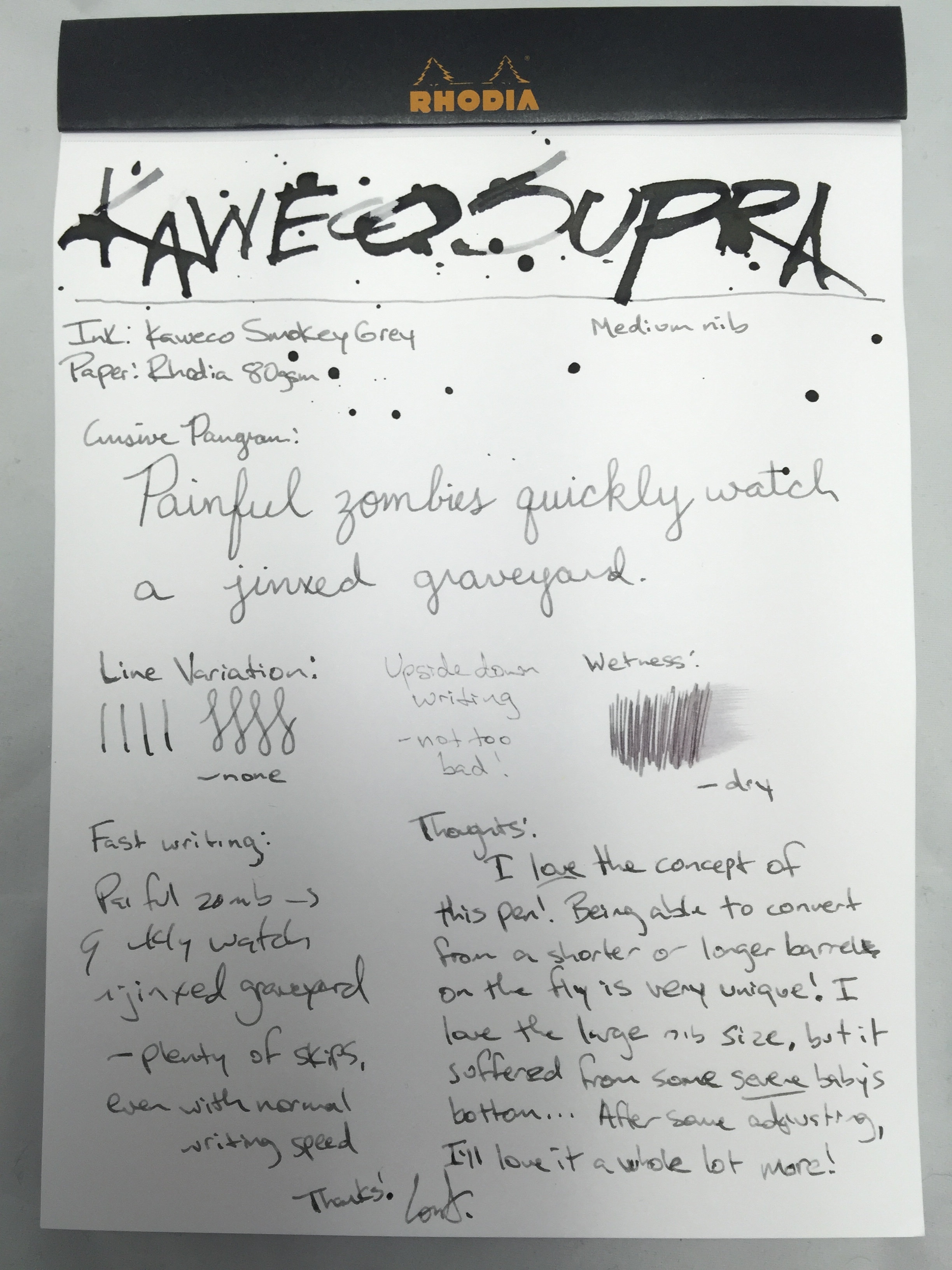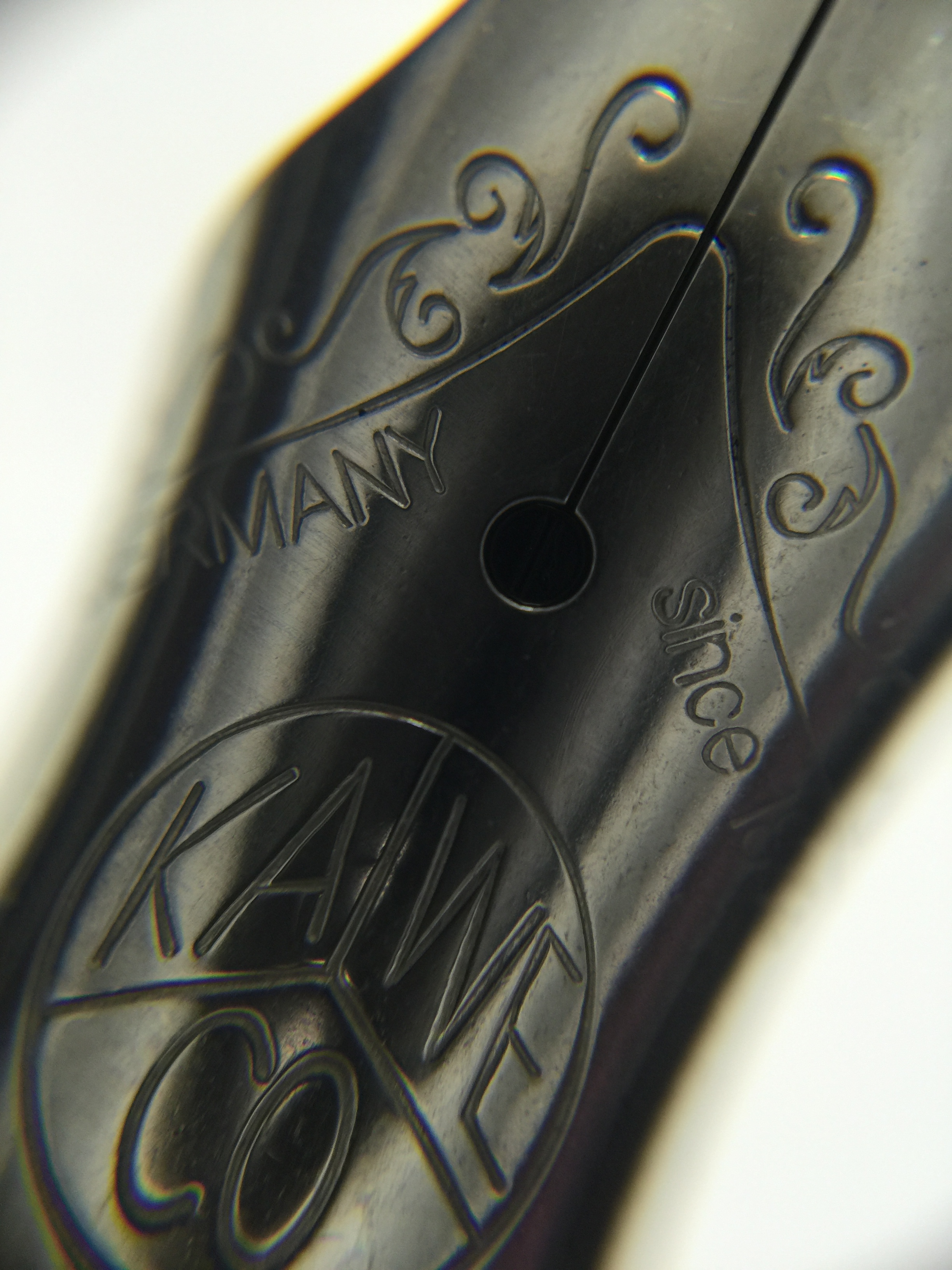Pen Review: Kaweco Ice Sport (Black)
Kaweco ICE Sport (Black) [M]
Paper: Rhodia 80gsm #16 blank (top staple)
Ink: Kaweco Sunrise Orange
Length Capped: 105mm
Length Posted: 132mm
Length Uncapped: 100mm
Section at Thinnest Point: 9mm
Section at Widest Point: 10mm
Weight w/quarter barrel of Ink & cap: 10.5g
Weight w/quarter barrel of Ink & no cap: 6.3g
Fast writing: Keeps up fairly well; couple of skips
Upside down writing: Pretty dry.
Wetness: Dry.
Pros: Can be eyedroppered, lightweight, lots of color options & nib sizes
Cons: Nibs can be finicky, may be too light for some, no really *good* converter options (see below)
Kaweco's ICE Sport is a demonstrator version of their flagship Kaweco Sport. The pen has the classic octagonal cap design, with the finial sporting the 3-syllable Kaweco logo. The body is a clear plastic with a section matching the color of the cap, which holds a standard a steel Bock nib. The pen is pocked-sized, which nice for portability, and it posts to a comfortable size for regular writing. This version is one of the new colors that Kaweco has introduced to this line, and is my personal favorite. They also have some other really neat colors like a florescent yellow, florescent orange, red, pink and many others.
What distinguishes the plastic Kaweco Sport pens from their aluminum and brass counterparts is the fact that they can be eyedroppered. If you're unfamiliar with that term, converting a pen to an "eyedropper" allows you to fill the barrel with ink instead of installing a cartridge or a converter (after adding a little silicone grease to the threads). Many people buy the Sports just for this reason, and with the ICE sport being clear, you get the added effect of being able to see your ink sloshing around in the barrel - which also lets you know how low your level is! The Kaweco pens are too short for a standard international converter, and unfortunately most of the Kaweco squeeze or plunge-type converters have been less than desirable to the masses, so eyedroppering is really the best option in my opinion. I've used the Templar Skinny Mini converter in my Brass and AL versions, but for the plastic I much prefer to eyedropper for both the ink capacity, and the look. Some folks have reported having burping issues with eyedropper pens; I've been fortunate not to experience that. I use my pens more for burst writing sessions instead of longer ones, and usually the cause is when the air in the pen is heated up by the hands.
Like a lot of Kaweco pens I've used, the nib suffered from a case of baby's bottom. It's a medium nib, but much to my liking, it wrote on the finer side of the spectrum. I don't care for super wide nibs anyways, so it was a pleasant surprise. I've heard a lot of people say that even Kaweco's broad nibs write closer to a western medium. I'm not sure if this is the case for all Bock nibs, or if Kaweco's are slightly different. Either way, I had to do some tuning on this one, and I still don't think I quite have it where I want it yet. Because this is a medium I think the issue is a little bit worse than it has been on some of my fine nibs. I will say that once they're tuned, they're really a pleasure to write with, just don't be surprised if you have to work on them a little bit.
The pen itself is very comfortable to hold and use. It is very light, though - between 6 and 10 grams depending on whether you use the cap, and slightly more if you have more ink in it. It may be a little too light for some folks, but I find it very comfortable. It's a little too short for me to use comfortably without posting, but it certainly can be done depending on your hand size.
So far, I've found the pen to be easy to clean, even when eyedroppered. I've had this ink in here for quite a while and it washed out just fine; I recommend using a q-tip to dry the barrel once you're done rinsing it, and at worst you can fill the barrel with some pen flush and let it soak a bit to get a more stubborn ink out.
I really enjoyed this pen, aside from the nib troubles. It's a beautiful design, and I'm a sucker for demonstrators. Kaweco have a great selection of colors with the ICE Sport, so you're likely to find something that'll suit almost anyone's taste. If you're interested in eyedroppering your Sport, I recommend Goulet Pens' silicone grease, but you can use just about any 100% pure silicone grease. The Kaweco ICE Sport sells at most US retailers for around $25; if you love a good demonstrator and want a good pocket/purse pen with a high ink capacity, you can't go wrong at that price!
(Kaweco has provided this product at no charge to The Desk for the purpose of review. My opinions are honest and without bias - visit the About Me page for more details).
Wanna be notified when new posts hit the blog? Head over to the Subscribe page and sign up for email notifications!















